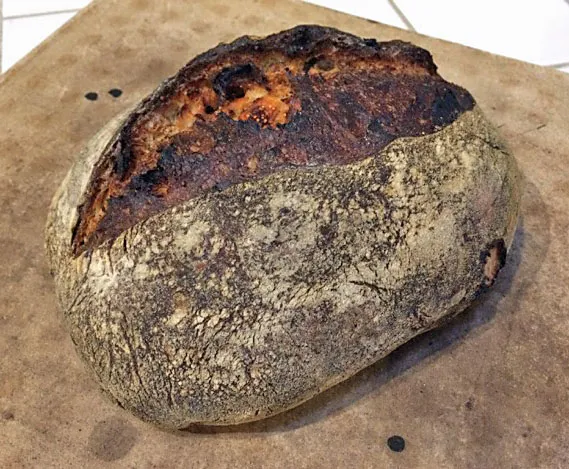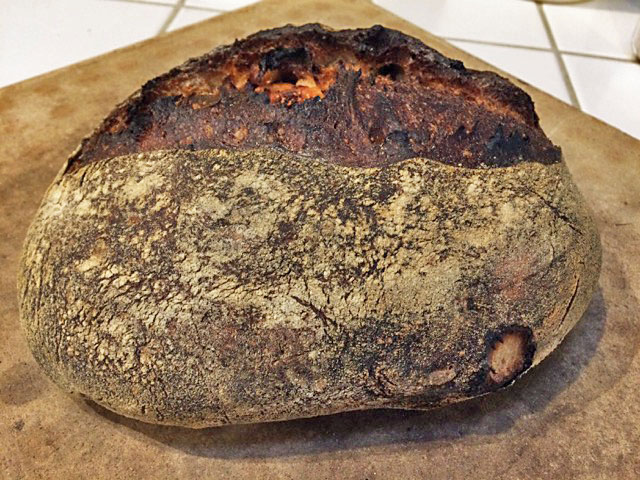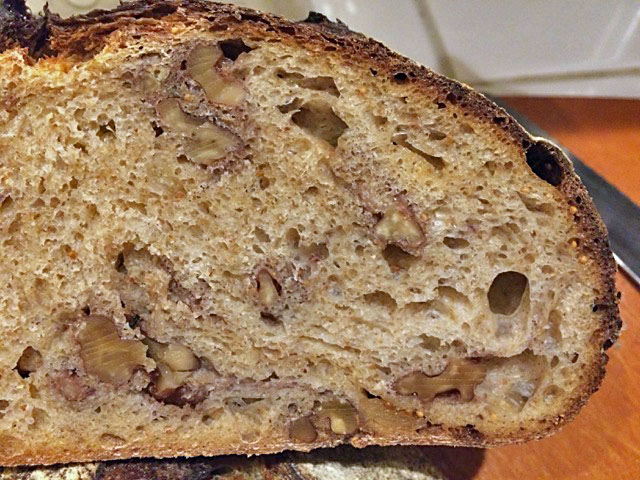
I have made sourdough breads with tart dried fruit and toasted nuts for many years. Recently, I have been less happy with the ones I have been making. I don't think the breads are any worse. I think my standards are higher. So, this week I tried adding figs and walnuts to my current favorite sourdough just to see how it worked. Well, it is a winner. It's my new favorite fruit/nut sourdough. It is lighter with a better aerated, moister, more tender crumb than others I have made, and the flavor is as good if not better than my previous best. The crust is nice and crunchy. Here are the formula and methods I used:
Walnut-Fig Mixed Grain Sourdough Bread
(based on Ken Forkish's “Field Blend #2” from Flour Water Salt Yeast)
David M. Snyder
April, 2017
Total Dough |
|
|
Ingredient | Wt (g) | Bakers' % |
AP flour | 350 | 70 |
Whole wheat flour | 62 | 12.5 |
Whole rye flour | 88 | 17.5 |
Water | 390 | 78 |
Salt | 10 | 2.1 |
Walnut pieces (toasted) | 100 | 20 |
Dried figs (coarsely diced) | 100 | 20 |
Total | 1100 | 220.1 |
Levain |
|
|
Ingredient | Wt (g) | Bakers' % |
AP flour | 72 | 75 |
Whole wheat flour | 18 | 25 |
Water (85-90ºF) | 72 | 75 |
Active starter | 18 | 25 |
Total | 180 | 200 |
In a medium bowl, dissolve the active starter in the water.
Add the flours and mix thoroughly.
Transfer to a clean bowl and cover tightly.
Ferment at 70-76ºF for 8-12 hours. It should have doubled in volume, have many bubbles on the surface and have a wrinkled surface. It should not have collapsed.
If you are not ready to use the levain when it is ripe, it can be refrigerated for up to a couple days.
Final Dough |
|
Ingredient | Wt (g) |
AP flour | 270 |
Whole wheat flour | 42 |
Whole rye flour | 88 |
Water (85-90ºF) | 310 |
Salt | 10 |
Walnut pieces (toasted) | 100 |
Dried figs (coarsely diced) | 100 |
Levain | 180 |
Total | 1100 |
Procedure
Toast the walnut pieces at 300ºF for 9 minutes. Cool completely.
Cut the figs (Calmyrna, preferred) into pieces about marble-sized. Place in a sieve and rinse under running water. Place the sieve with the figs over a bowl to drain.
In a large bowl, mix the flours and the water to a shaggy mass. Cover the bowl and let it rest (autolyse) for 20-60 minutes.
Sprinkle the salt over the dough, then add the ripe levain in 4-6 portions.
Using a spatula or your hands, mix the dough to evenly distribute the salt and levain. Note: My preferred method is by hand. I wear a food-grade “rubber” glove, dip the fingers in water frequently and use the French technique of squeezing the dough between my fingers many times, alternating with stretching and folding the dough.
When you feel the ingredients are thoroughly mixed, transfer the dough to a clean, lightly oiled clean container and cover it.
Bulk ferment for 50 minutes.
Transfer the dough to a floured board. Stretch is to a rectangle about 12 X 18”. Distribute the figs and walnuts evenly over the surface of the stretched out dough. Fold the dough. Repeat the stretching and folding a few times to distribute the figs and nuts evenly. Return the dough to the bowl and cover.
Bulk ferment for another 50 minutes. Do another stretch and fold and return the dough to the bowl.
Bulk ferment for another 50-90 minutes. The dough should be well aerated.
Transfer the dough to the board and pre-shape as a ball. Cover with a cloth and let the dough relax for 10-30 minutes.
Transfer the loaf to a well-floured banneton or brotform. Note: flouring the banneton/brotformen with a 50/50 mix of AP and Rice flour works best to prevent the dough from sticking to the proofing basket. Place the loaf in the basket in a food-grade plastic bag or cover well otherwise. Let the dough relax and start proofing at room temperature for a half hour or so.
Refrigerate for 8-12 hours.
Take the loaf out of the fridge but leave covered.
With a baking stone on the oven's middle rack and your steaming apparatus of choice in place, pre-heat the oven to 500ºF for 45-60 minutes.
Allow the loaf to proof for up to 90 minutes. It can be baked right out of the fridge I am told. (I never have done that.)
Uncover the loaf and sprinkle it with semolina or cornmeal.
Transfer the loaf to a peel and score as desired.
Turn down the oven temperature to 460ºF. Steam your oven and transfer the loaf to the baking stone. Note: My method of oven steaming uses a 9” cast iron skillet filled with the kind of lava rocks used with gas grills. This is pre-heated along with my baking stone. The skillet sits off to the side on an oven rack below the one that holds the baking stone. To generate steam, I fill a perforated pie tin with a single layer of ice cubes. This is rested on top of the lava rocks just before I load the loaves onto the pizza stone.
After 15 minutes, remove the steam apparatus.
If you have a convection oven, switch to convection-bake at 435ºF. Otherwise, leave the oven at 460ºF conventional bake. Bake for another 30-35 minutes. Check the loaf after 30 minutes. If it is not fully baked but is getting too dark, turn down the oven temperature by 10ºF or so and bake until fully baked.
The loaf is fully baked when the crust is darkly colored, tapping the bottom of the loaf gives a hollow sound and the internal loaf temperature is 205ºF or higher.
Remove the loaf to a cooling rack and cool completely before slicing.


Enjoy!
David
- dmsnyder's Blog
- Log in or register to post comments
That would be even better in my mouth than it is in the picture.
Paul
This one is highly recommended.
David
78-82% hydration for fruit and nut breads, We like the whole grains to be in the mix of Kamut, spelt, rye and red and white wheat. It must taste about the same. Sprout them and you have a different bread too. Especially love the dark bake on this one too. Very nice inside and out for sure.
Well done and happy baking David
I haven't tried figs in bread yet but that is on the list. That must be one delicious loaf!
figs, walnuts and bread.. as the song goes.. some of my favorite things.. thank you for sharing!
That definitely has to be one of the tastiest combinations for a bread (especially with the rye in there - goes so well with figs).
Thanks for sharing such a perfectly detailed formula and instructions - along with the stunning result!
I definitely want to make this. figs, walnuts - heaven!
claudia
If you do make this bread, please let us know how it works for you.
Happy baking!
David
Hi David! I often browse TFL for ideas when I am about to make another bread, and I came across your formula that I used with a couple of changes. I had some toasted hazelnuts in my freezer (a la Trader Joe's) and used them in place of the walnuts. Also i used a baking method that I have grown to like. After removing the rising basket from the refrigerator this morning, I let it stand at room temperature for a couple of hours and then put it a cold oven in a Dutch oven with the lid on. I then set the oven for 425 for 30 minutes and removed the lid for the final baking time. At the end of the baking time I turned on the convection setting at 400.
Although dough seemed a bit sluggish and a little stickier than usual, the result was very good- extremely delicious!
So thank you for your inspiration David.
Thanks for sharing!
Hazelnuts are great in sourdough bread. A combination of hazelnuts and walnuts is also good.
David
As always :-) I was just looking to bake something different for my parents, while I am visiting, and it so happens that they have dried figs in the refrigerator as well as walnuts. I packed my liquid "pasta acida" with me and brought it oversees, so I could spoil my folks with some homemade bread. They live in Genzano, so good bread isn't a problem to find, but homemade from their daughter is even better :-D. (But I do enjoy the pizza Bianca here, is one of those things that I miss a lot back in the States, among the taste of my dad's home grown tomatoes).
Grazie mille :-)
I hope your parents enjoyed the bread.
I imagine you used locally available flours. What did you use, and how did it work?
I have enjoyed traveling (and eating!) in Italy very much, but I haven't been South of Toscana. I hope you will share some photos of Genzano and tell us about the area.
David
I missed your reply!
The bread was so good, not that I had any doubt. I follow your recipes and bake some of them very frequently. My youngest one can't get enoug of your Italian Baguettes with semolina. One day I came back from work and he ate a whole loaf all by himself! Not that I am surprise.
I used Garofalo flours, while I have used their pasta often (trafilata al bronzo) I have never used their flour, I think it's a new addition. They have 3 different levels, W170, W260 and W350. Semola rimacinata is very easy to find in any grocery store there, I wish I could have packed a bunch to bring back here.
Genzano is a nice small town, one of the biggest events there is The Infiorata, where one of the main road is completely covered in beautiful pictures made entirely with flower petals, and it dates back to the 1700. This year I was able to go with my kids and have them partecipate to the Spallamento of the Infiorata, which is when all of the kids go and destroy the entire thing at the end of the three days event. I'll see if I can upload some pictures.
The famoso pane di Genzano is something that I grew up enjoying on a regular basis, back home, but the pizza bianca is something that I truly miss here in the States. My parents sometimes buy it fresh from the local store and serve it filled with fresh local mortadella (no, not bolony!!!) or fresh figs and prosciutto, yum!
I have been using a very nice recipe for pizza al taglio from a famous Roman pizza maker Gabriele Bonci. His pizza dough is super wet and usually made with regular yeast in small quantities and long cold retardation. But lately I have been doing the same recipe using sour dough, following another Italian blog, and I have to say it is worth the extra work :-). Maybe I'll post the process one of these days. I am not a very technical type of baker, I rely more on my instincts, so sometimes it is hard for me to explain processes:-P, something you are really good at :-).
I am off to make some more bread for the week. Happy Baking :-)
Sorry, that posted before I meant it to. Other than baking in a Challenger Bread Pan, I followed your method exactly, David. Thanks again for the formula. More pics below.